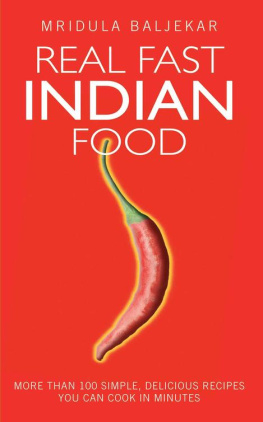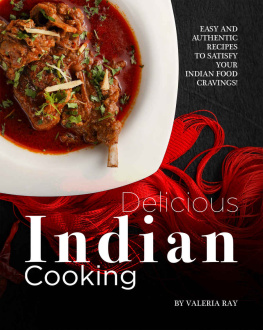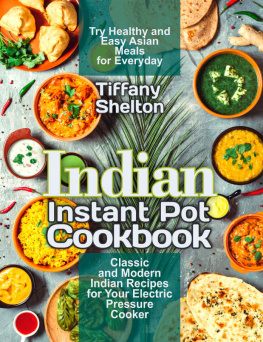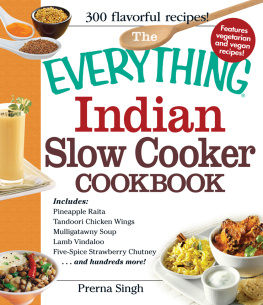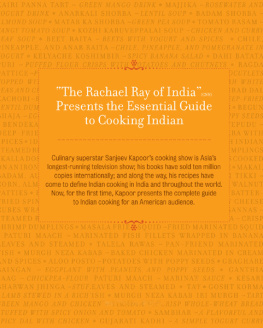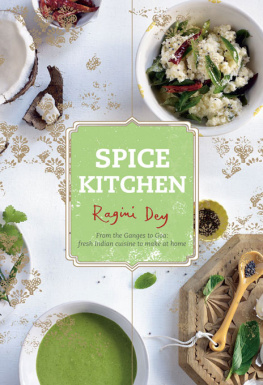Preparation times are a guide to making and cooking the recipes, but do not include freezing, standing or chilling, where necessary.
Where a guide to microwave cooking is given, times are based on using a microwave with an 850-watt output.
Indian food, authentic and fast? Impossible its a joke!
I would not blame you for questioning the concept of speeding up proper Indian cooking, because you would be right to be sceptical before looking at this book!
With the demands of todays busy lifestyles, spending time cooking and preparing meals for the family, or when entertaining, is becoming more and more difficult. Sometimes it is also easy to forget about the nutritional value of everyday meals. Never before have we had such a wide variety of ingredients from which to select and this ever-increasing choice of foods can make shopping bewildering. However, many foods are intended to make life that little bit more convenient ingredients from around the world not only are available but are often sold prepared and ready to cook. Meat and poultry can be bought trimmed and diced; vegetables washed, chopped and ready to serve in salads; there is also a terrific array of spices and spice pastes for adding instant flavour when cooking. Although I prefer to prepare ingredients myself, these convenience products can be very useful when, in addition to doing a days work outside the home, we play the roles of family chauffeur, housekeeper, cook and cleaner.
Creating attractive and delicious Indian dishes is not as time-consuming as is generally believed. It is possible to cook a nutritious and visually appealing Indian meal without spending hours in the kitchen. In fact, you can present a wonderful feast within an hour or less! The trick is to combine a little organization with a few simple, but vital, steps to success. Once you have mastered this, you will be amazed how quickly you can invalidate the idea that Indian cooking is complicated and lengthy.
A Little Organization
By this, I do not mean an entire change of lifestyle. All it involves are four simple principles.
1 Always keep the storecupboard well stocked.
2 Have the ingredients accessible, next to the hob or oven, before starting to cook.
3 Have the cooking utensils and all other equipment within easy reach.
4 Read the entire recipe and make sure that you understand it fully before you start preparing the food or cooking. Not only will this save time, but it also helps to prevent mishaps.
Key Steps to Success
The following will help you to succeed with speed.
1 Use pre-blended spices (see page 14) whenever possible. Spending a few minutes blending and storing spices appropriately cuts down preparation and cooking time when you are making a meal. This is particularly useful when you are preparing a meal for friends, as they would like to spend time with you, not just catch the occasional glimpse of your apron!
2 Either buy or make your own ginger and garlic pures (see page 16). Preparing small amounts of ginger and garlic can be comparatively time-consuming, so spending a little time to prepare a large batch of these frequently used basic ingredients will cut down the effort involved in making individual meals. Both pures can be kept in the refrigerator for up to 15 days or they can be frozen for up to 6 months.
3 Use one of the three cook-ahead sauces (see page 16) to create a delicious curry in a hurry. If you want to buy prepared curry sauces and pastes, then add a few spices of your own to enhance their flavours. Generally, a few whole spices, such as cinnamon, cardamom, cloves and bay leaves, will transform a bought product. These should be added to the oil first and cooked briefly. Then add fresh herbs, such as coriander and mint, and use fresh chillies and tomatoes as appropriate.
4 Have hot water ready to add to a dish. This is important in Indian cooking not only to retain the flavours of the carefully blended spices, but also to enhance them, making all the difference to the flavour of the finished dish. Remember to put the kettle on to boil while you prepare the ingredients. It is also quicker to add hot water when cooking rice, rather than waiting for the water to boil in the pan.
5 Take advantage of all the time gaps between the different stages of a recipe. For instance, while lentils or meat are simmering, start preparing the ingredients for the next dish. Frying onions is probably the most time-consuming step in an Indian recipe as it can take up to 15 minutes to cook them properly. Remember, you do not have to attend to them constantly, but can get on with another part of the recipe or another dish in the meantime.
6 When you are cooking dry dishes, such as kababs (kebabs), make double the quantity and chill or freeze half for future use. Kabab mixes can be prepared in seconds in a food processor and you can create an entirely new dish by cooking the second half of the batch with one of the sauces you will already have in the refrigerator or freezer.
7 Leftover meat and poultry dishes can be transformed into a new meal by turning them into instant pilaus. Simply mix them with boiled basmati rice and garnish with fried onions or toasted nuts. All you need is a raita and some pappadums to complete the meal.
8 For side dishes, as far as possible make raitas as they do not need cooking and take only a few minutes to prepare. With the right combination of ingredients they are tasty as well as nutritious.
9 If you have a microwave, make use of it for the many Indian dishes that can be cooked very successfully by this method. For example, the microwave is great for cooking rice simply start it off, then forget about it. This is also a practical method for par-cooking potatoes and other vegetables before spicing them up in a jiffy on the hob.
10 A pressure cooker is another useful piece of equipment. Lentils and beans can be pressure cooked in less than half the time taken for boiling. Add the tadka (the seasoning mix) to transform plain cooked pulses it into a delicious dish. Lentils cook in 78 minutes in a pressure cooker and potatoes can be cooked in a separate dish (with a little water added) at the same time. Cut the cooked potatoes into bite-sized pieces and toss them in hot oil with a few spices.
11 Use canned beans and peas to save time. They work very well if they are drained and rinsed thoroughly first.
12 Peeling vegetables can take time. Since most of the nutrients are found immediately under the peel, I often choose young vegetables and new potatoes which do not need peeling. Carrots are the exception as they are best peeled (even the baby ones) to remove traces of chemicals. To ensure that the flavours of the spices penetrate unpeeled vegetables, make small incisions through the peel or prick them with a fork before cooking. Making small incisions also cuts the cooking time slightly.
13 Lastly, choose cuts of meat that cook quickly and buy them ready diced or cut them into small bite-sized pieces to reduce the cooking time. Similarly, cut vegetables into small bite-sized pieces which cook more quickly than large chunks.
Now you are fully prepared to challenge the taste buds with exotic, highly nutritious and superbly flavoured food which does not demand hours of preparation and cooking.
This is my way of taking Indian cooking into the new millennium I hope you will find it useful and that it will be a source of pleasure for years to come.
Bon apptit.
Putting my idea of organization into action is not difficult. Identifying the useful basic ingredients and making sure you keep them in stock, in their most useful form, will help to speed up shopping, food preparation and cooking. From ensuring the storecupboard is full of useful ingredients to having a stock of prepared spices and sauces, setting aside time occasionally to top up the supply of essentials is not as time-consuming as starting from scratch every time you cook an Indian meal.

